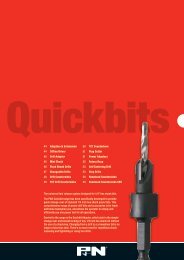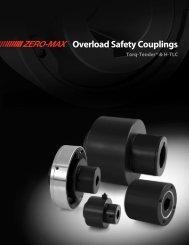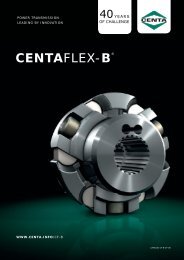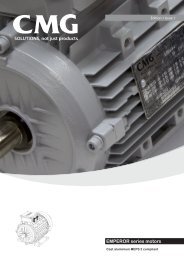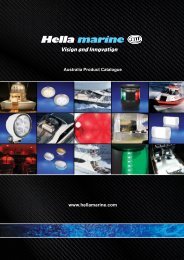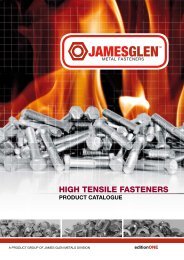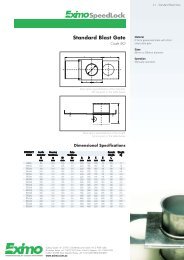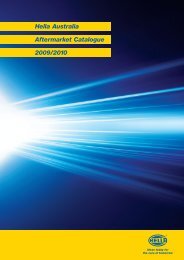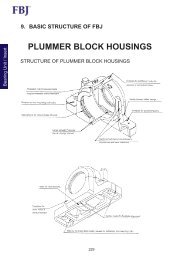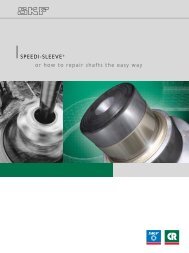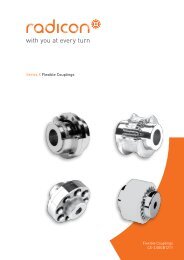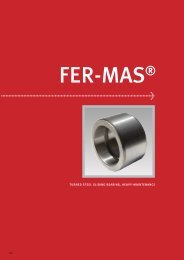Barrel Couplings - Industrial and Bearing Supplies
Barrel Couplings - Industrial and Bearing Supplies
Barrel Couplings - Industrial and Bearing Supplies
You also want an ePaper? Increase the reach of your titles
YUMPU automatically turns print PDFs into web optimized ePapers that Google loves.
<strong>Barrel</strong> <strong>Couplings</strong>Torsionally rigid couplings
CONTENTGeneraldescriptionGeneralfeatures1Type<strong>and</strong> elements2TechnicalspecificationDimensions3Selection of coupling4Assembly instructions5Alternativ constructions6TSCHAN - <strong>Barrel</strong> Coupling 3
GENERAL FEATURES1.0 GENERAL FEATURESTschan TK barrel couplings are recommended for installation in crane lifting mechanisms, to connect the cable drum withthe gearbox output shaft, as well as in winch conveyors <strong>and</strong> platform hoists.By selecting the coupling size (table 1), it is necassery to consider the radial load (ST), the dimension of the gearbox shaft(d min – d max) <strong>and</strong> especially the transmission torque (T) with the operating factor (K1) in table 3.When the gearbox output shaft is rigidly connected to the drum in a lifting mechanism, supported between three points, thisoriginates a statically indeterminate case (Fig. 1)This type of mounting requires special care in alignment <strong>and</strong> levelling, which is difficult to achieve in practice.Mounting inaccuracies, as well as deformation in structures <strong>and</strong> wear in moving parts, lead to enormous additional forces,above all in the gearbox output shaft, which is a result of alternative bending loads can lead to breakage due to faults inbearings <strong>and</strong> gear wheels.In the recommended mounting Fig. 2, the barrel coupling, which is installed between the gearbox <strong>and</strong> cable drum, performsthe function of an articulated joint, thus making the connection statically determinate <strong>and</strong> avoiding the occurrence of highbending moments.Fig.1Rigid mounting of gearbox-drum connectionSupport at three points – static uncertainFig.2Mounting with barrel coupling – static certainELASTIC TSCHAN - COUPLING TYP SGEARBOXCABLE DRUMFig.3 shows the mounting of the barrel coupling in alifting mechanism. Considering the fact that this couplingallows axial displacement, a self-adjusting bearing mustbe mounted, fixed laterally, at the opposite end of thedrum shaft in order to withst<strong>and</strong> the axial forces thatmay be genarated.As a special application, the TK barrel coupling can bedisigned as an articulated joint that withst<strong>and</strong>s axialforces by itself.TSCHAN BARREL - COUPLING4TSCHAN - <strong>Barrel</strong> Coupling
TYPE AND ELEMENTES2.0 TYPE AND ELEMENTSThe barrel coupling consists of a sleeve provided with semicircular toothing around its internal diameter <strong>and</strong> a hub that isexternally toothed in a similar way. A series of cylindrical barrels, of hardened steel, are inserted in the holes formed by thistoothing to act as power transmission elements.Covers with their corresponding special seals (Pos. 8, Fig. 4) serve to assure the perfect-tightness of the inner zone,preventing the penetration of dust <strong>and</strong> guaranteeing the continuity of the necessary lubrication. Two double-lamina elasticrings mounted on the hub, one on each side of the toothing, limit the axial displacement of the barrels.Torque is transmitted to the drum’s receiving flange, generally by two diametrically opposed flat driving surfaces, located atthe periphery of the coupling flange, <strong>and</strong> also by means of bolts which, at the same time, serve as connection with the drum.The discribed design is appropriate for large bearing radial loads, as these are distributed over large barrel support surface.In the same way, this design also minimises the effect of alternative bending of the torque on the toothing, the latter beingrobust thanks to its low height <strong>and</strong> large bottom section. In addition to this, due to the effect of “crush polishing” of thehardened barrel on the tooth profile, its wear resistance is appreciably improved.An indicator located on the external cover (Pos. 7, Fig. 4) which moves relative to the marks on the hub as a funktion ofwear, permits control of internal wear of the toothing, without the need to disassemble any part of the coupling. The sameindicator also serves to control the axial position of the sleeve relative to the hub.Fig.41 HUB2 SLEEVE FLANGE3 INTERNAL COVER4 EXTERNAL COVER5 BARREL6 FIXING SCREW7 POINTER8 DOUBLE-LIP SEAL9 FIXING SCREW10 WITHDRAWING THREADING11 WEAR NOTCHES12 LUBRICANT SUPPLY13 OVERFLOW HOLE14 ASSEMBLY MARKING15 RETAINING RINGTSCHAN - <strong>Barrel</strong> Coupling 5
DIMENSIONS AND PARAMETERSTable 2aD T S (F8) a (min.) d1 d2 d3 (F8) P n (min.)Size Ø Ø Ø Thread Ømm mm mm mm mm mm mm mm25 250 220 220 16015 M 1250 280 250 250 18075 320 280 280 200100 340 300 300 22025130 360 320 320 24019 M 1610160 380 340 340 2603,0200 400 360 360 280300 420 380 380 310400 450 400 400 34030600 550 500 500 4201000 580 530 530 40 24 M 20 450 201500 650 600 580 53050252600 680 630 600 5603400 710 660 640 6005,04200 780 730 700 60 28 M 24 670356200 850 800 760 730CABLE DRUM FLANGE,COUPLING SIDEFlange holesFig.4Type 25 - 600Fig.4THE DESIGN OF THE CABLE DRUM FLANGE MUST BE ACCORDING TO FIG. 4 AND TABLE 2Type 1000 - 1500Table 2bD T S (F8) a (min.) d1 d2 d3 (F8) P n (min.)Size Ø Ø Ø Thread Øinch inch inch inch inch inch inch inch25 9,843 8,661 8,661 6,2990,591 M 1250 11,024 9,843 9,843 7,08775 12,598 11,024 11,024 7,874100 13,386 11,811 11,811 8,6610,984130 14,173 12,598 12,598 9,4490,748 M 160,394160 14,961 13,386 13,386 10,2360,118200 15,748 14,173 14,173 11,024300 16,535 14,961 14,961 12,205400 17,717 15,748 15,748 13,3861,181600 21,654 19,685 19,685 16,5351000 22,835 20,866 20,866 1,575 0,945 M 20 17,717 0,7871500 25,591 23,622 22,835 20,8661,9690,9842600 26,772 24,803 23,622 22,0473400 27,953 25,984 25,197 23,6220,1974200 30,709 28,740 27,559 2,362 1,102 M 24 26,3781,3786200 33,465 31,496 29,921 28,740Type 2600 - 6200Fig.4TSCHAN - <strong>Barrel</strong> Coupling 7
SELECTION OF COUPLING SIZE4.0 SELECTION OF COUPLING SIZEThe required coupling size depends on:1. Transmission torque T (Nm)2. Radial load by the coupling S T(N)3. Dimesions check of the gearbox shaft4.1 Transmission torque T (Nm)a) Based on installed power Ni (kW)4.2 Determination of the radial load S(N)Radial load is understood to be the fraction of the loadthat must be withstood by the coupling due to the pull ofthe load <strong>and</strong> the hoisting tackle. As the couplingconstitutes one of the drum’s two supports, it mustwithst<strong>and</strong> a fraction of the total load.Prior to calculation the radial load S, it is necessary to obtainthe static load S Rin the drum.Eq 1T(Nm) = (N i/ n) x 9550 x K 1Determination of static load S Rin the drumTable 3groupgroupN i= max. installed power of the motor (kW)n = drum turning speed (1/min)K 1= operating factor (table 3)DIN 15020FEM (1970)1 Bm1 Am2 m 3 m 4 m 5 mIBgroup FEM (1987)M1,M2,M3M4M5M6M7M8group bs 466 (1984)operation factor K 1,121,251,401,601,802,001IAIIIIVVEq 5S R(N) = (Q + G) / i rQ = max. load on hook (N)G = weight of hoist tackle <strong>and</strong> cables (N)i r= transmission ratio(Total number lines: Number oflines leaving the drum)K 2= Operating factor drum (hoist tackleefficiency) table 4Eq 2b) Based on consumed power Nc (kW)N c(kW) = (S Rx V T) / 60.000The static load is modified if cable <strong>and</strong> pulley efficiency K 2is taken into account according to table 4Eq 6S R(N) = (Q + G) / (i x K 2)Eq 3Eq 4T(Nm) = ((N cx 9550) / n) x K 1orT(Nm) = S Rx (D/2) x K 1Table 4i rHoisttackle reduction2 3 4 5 6 7 8K 2K 2with bronze bearings0,920,900,880,860,840,830,81with ball bearings0,970,960,950,940,930,920,91N c= max. consumed motor power (kW)S R= drum static pull, incl. cable <strong>and</strong> pulleyeffciency in Newton (N) (see Eq 6)V T= drum cable lifting rate (m/min)n = drum turning speed (rpm)D = drum pitch diameter (m)K 1= operating factor (table 3)Figureres 1 to 4 below, show different examples of hoisttackle configuration.Fig.1 Fig.2 Fig.3 Fig.4The optained transmission torque T(Nm), by means of theinstalled or consumed power, must be less than thetransmission torque Tmax (Nm), shown in table 1.After this, it is necessary to confirm the selection on thebasis of the radial load to be withstoodTwin hoist,2 sheavesdouble lineto drumTwin hoist,4 sheavesdouble lineto drumHoist,2 sheavessingle lineto drumTwin hoist,4 sheavessingle lineto drumi r= 2 i r= 4 i r= 4 i r= 8S R=(O+G)/2 S R=(O+G)/4 S R=(O+G)/4 S R=(O+G)/88TSCHAN - <strong>Barrel</strong> Coupling
ASSEMBLY INSTRUCTIONAfter obtaining the static pull, it is necesarry to calculatethe load S (N) by using the following equation:For examples fig. 1 + 2Eq 7S(N) = (S R/ 2) + (w / 2)S R= drum static pull, incl. cable <strong>and</strong>pulley efficiency in Newton(see EQ 6)I = distance between drum supports(mm)b = shortest possible distance fromcable in drum, to the geometriccentre axis of the barrels, into thecoupling (mm)w = Own weigt of the drum with itcables <strong>and</strong> couplings parts linkedto it (N)5.0 ASSEMBLY INSTRUCTIONPrior to drilling the holes for the fastening of support,axially fix the position of the drum with respect to thecoupling’s hub. In this case, the front edge of the pointermust be line up with the mark on the hub (see fig …..)During assembly, axial displacement must not exceed10% of the maximum nominal value admitted by thecoupling, according to table 1.POINTERLUBRICANT HOLETOPFor examples fig. 3 + 4Eq 8S(N) = (S Rx (1 - (b / l))) + (w / 2)REFERENCE LINE FORAXIAL POSITIONINGHUBObtained the radial load S, it is necessary to check that theadmissible radial load S, of the select coupling (see table 1)is bigger than Smax.In the event that the transmission torque T is lower thanthe nominal torque of the preselected coupling Tmax., butthe radial load S to be withstood by the coupling is biggerthan the admissible catalogue load Smax for this size ofcoupling, then it is possible to get a final verification, bychecking whether the coupling can withst<strong>and</strong> a radial loadS Awhich is higher than the coupling’s admissible loadSmax, indicated in the catalogue:S A= S+((Tmax-T)xC) C= Compensation factorvariable according to couplingsize (table 5)Table 5After this, the angle aligment is checked by measuring thegap “x” at four points with a separation of 90° by using areference ruler (fig…). The difference between the fourmeasurements should not be higher as the following figuresare shown:0,30 mm for sizes = / < TK- 6000,60 mm for sizes = / > TK-1000RULERCABLE DRUMCouplingSize255057 100130160200300400600100015002600340042006200FactorC 10,3 9 8 7,2 6,4 5,8 5,2 4,8 4,1 3,4 3,0 2,6 2,4 2,2 2,0 1, 8Compensation is only applicable to the radial load, not tothe torque4.3 Dimension check of the gearbox shaftAlso, a check by the dimenson of the gearbox shaft must bedone, if it is smaller , as the maximum admissible diameterdmax. for each coupling size, according to table 1. Thesevalues are valid for shafts with keyways according to DIN6885 / 1. Additionally, a ckeck must be done, of the pressureto the keyways.For other types of fixing, such as splin shafts according toDIN 5480, mounting with interference, etc. , pleasecontact our technical department.The Tschan barrel coupling is supplied as a wholeunit, ready to be mounted, but not provided withlubricant. Before it is put into service, it must belubricated in the required quantity with theappropriate lubricant, as indicated in the assembly<strong>and</strong> service manualTSCHAN - <strong>Barrel</strong> Coupling 9
ALTERNATIV CONSTRUCTIONS6.0 ALTERNATIV CONSTRUCTIONFor alternativ constructions, see types below,please contact our technical department.Type TKBWith axial fixed barrelsType TKSGAdditional axial lock for metallurgicalengineering, as per st<strong>and</strong>ard SEB666212 (Jan.91)Type TKNGear designedType TKSIAdditional axial lock for the frenchmetallurgical engineering, as perst<strong>and</strong>ard SIDMAR BR3-550(01-10-1998 Rev.D)10TSCHAN - <strong>Barrel</strong> Coupling
NOTESTSCHAN - <strong>Barrel</strong> Coupling 11
TSCHAN GmbHZweibrücker Strasse 104D - 66538 NeunkirchenTelefon: +49(0)6821/866-0Telefax: +49(0)6821/88353Internet: www.tschan.deE-Mail: postmaster@tschan.deCompetent agencies troughout the world quarantee prompt information, delivery <strong>and</strong> service.The full list of TSCHAN-agencies is available on request.



